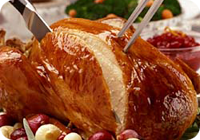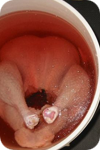Let’s Talk Turkey

When I think of my brief, yet humble career as an amateur chef, I divide my life into two parts: BB and AB. That is to say my life ‘Before Brining’ and my life ‘After Brining’. What is brining? To put it quite simply, brining it is a cheap, and relatively easy technique to help ensure that your Thanksgiving turkey turns out as delicious and juicy as it possibly can. It is essentially a marinade that delivers both flavor to the meat and helps lock in juices when the turkey is exposed to the high temperatures of cooking. I first learned the tip from Alton Brown and his awesome cooking show, Good Eats and have been using it every year since without fail. No matter if you plan to roast, fry or spin your turkey on a giant rotisserie, brining your bird is the first step on the road to culinary fullfillment.
There are many ways to accomplish the brining, but I’ve stuck with Alton’s method and recipe. You’ve heard of the expression “If it ain’t broke, don’t fix it”? Yeah, well that applies here so I’m going to give you the low down on just how I go about working the turkey magic.
The easiest container I’ve found to brine in is one of those big 5 gallon paint buckets from Home Depot. Go pick up a brand new one, and then give it a good hand washing before you get ready to brine. For a 14-16 pound bird you’ll want to brine for a good 12-24 hours, so plan ahead. Rinse the turkey completely inside and out and remove any packets of giblets and the neck that may be hiding in the body cavity. I almost forgot to to this one year believe it or not, so it’s always best to double check.

Turkey Brine Recipie:
1 cup kosher salt
1/2 cup light brown sugar
1 gallon vegetable stock
1 tablespoon black peppercorns
1/2 tablespoon allspice berries
1/2 tablespoon candied ginger
1 gallon iced water
Combine all brine ingredients, except ice water, in a stockpot, and bring it to a boil. Stir to dissolve all the solids and then remove from the heat. Cool the mixture to room temp. and refrigerate until thoroughly chilled. The chilling part is important since you don’t want your turkey to go into a hot or even warm solution (can you say bacteria people?). Early on the day of cooking, (or better on the night before) combine the brine and ice water in your clean 5-gallon bucket. Place thawed turkey breast side down in brine, cover, and refrigerate or set in cool area like a basement or a garage. Turn the turkey over once half way through.
When it’s time to cook, remove the bird from the brine and rinse thoroughly. You may see that the color of the skin and meat has darkened slightly, that is a good thing. It just means that the brine did its work and the flavorings have penetrated into the turkey. A few minutes before roasting, heat your oven to 500 degrees. I use Alton’s method of filling the turkey’s cavity with fresh aromatics instead of bread stuffing. Stuffing dries out the meat and prolongs cooking time and I’ve found it’s best to avoid it.
Turkey Aromatics:
1 red apple, sliced
1/2 onion, sliced
1 cinnamon stick
1 cup water
4 sprigs rosemary
6 leaves sage
Combine the apple, onion, cinnamon stick, and cup of water in a microwave safe dish and microwave on high for 5 minutes. Place your bird on roasting rack inside a wide, low pan and pat dry with paper towels. Add steeped aromatics to the cavity along with rosemary and sage. Tuck back wings and coat whole bird liberally with canola (or other neutral) oil.
Roast on lowest level of the oven at 500 degrees F. for 30 minutes. Remove from oven and cover breast with double layer of foil, insert probe thermometer into thickest part of the breast and return to oven, reducing the temperature to 350 degrees F. Set thermometer alarm (if available) to 161 degrees. A 14 to 16 pound bird should require a total of 2 to 2 1/2 hours of roasting. Let turkey rest, loosely covered for 15 min. before carving.
Trust me when I say that you will never have un-brined turkey ever again. I’ve heard people say that frying your turkey is the only way to lock in juices and ensure your bird doesn’t get dried out. To those people I say “Ha!” you don’t know jack. A brined and roasted bird is just as flavorful and juicy as any fried turkey could ever hope to be. Give it a try, I promise you won’t be disappointed.
Couldn’t agree more about brining. I saw the salty light about three years ago and haven’t looked back.
I’ve been doing the same thing ever since I saw AB do it the first time. It turns out really well, and I also highly recommend his Cornbread Stuffing from the same episode.
Last year, though, he actually rigged this whole derrick thing to safely do a fried turkey (the plans are on his website). I’m tempted because it sounds tasty, but a couple of gallons of fire-hazard-in-a-pot still scares me.